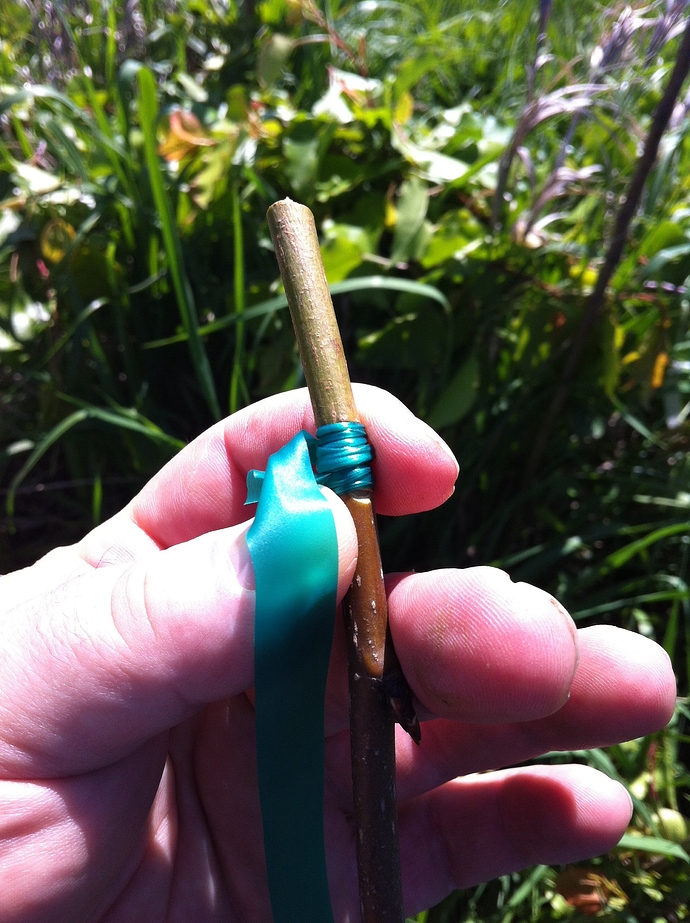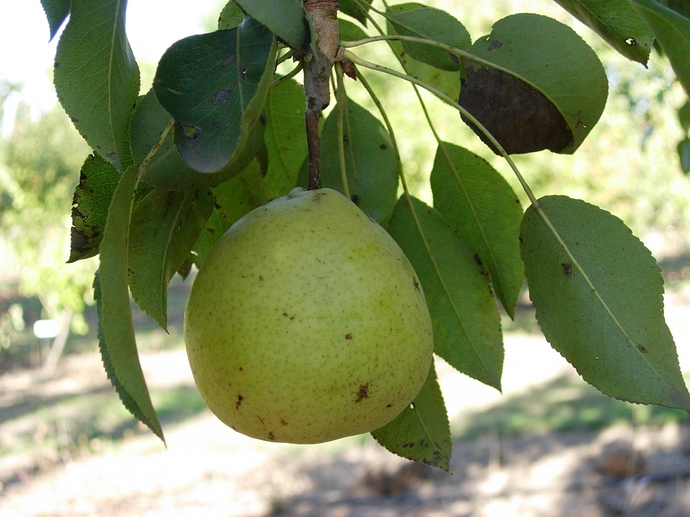I wouldn’t touch em at all. If scions were in good condition, apple scions really don’t need to be wraped. I do coat em with parafilm nowadays but didn’t for some years. With apples I had almost similar success. It’s more like an insurance. Since you didn’t wrap them I would now rate the risk coming with “emergency measures” higher than the potential benefits.
My only concern which is not a big concern at this point is that the wood might dry out before it takes. If the next week brings similar temperatures then I would be a little concerned but I suspect it will get warmer quickly.
The next 4 days are pretty much all rain so no drying will occur. I figure whatever damage has been done in the last 2 weeks won’t be repairable by covering them so I think I’ll do what I’m an expert at…nothing!
Noob question:
Is there a big difference in apple varieties re: how well they graft?
Hope you have better luck then me. Mine grew 4 nice leaves and then died last year. I’ll try again this year but will not graft until warmer weather in May.
Having read the late Lon Rombough’s excellent “The Grape Grower,” (but never having tried growing grapes) I believe you could make it work. You might try both: grafting on them while waiting for roots and plan on grafting onto some that root this year for next season.
I’ve learned all kinds of things by trying what seems like a different idea. That is how I learned to propagate African violets via side growth crowns. I’d done it with single leaves (gotta get 'em fairly young) and that takes a while, but once I tried dusting a tiny crown with Rootone and putting it on fresh soil in a north window, the take is wonderful and growth quick.
The short answer: yes.
Some make brittle graft unions, such as Gala. Some have incredibly soft twig wood. I grafted Winekist and GoldRush today. Winekist cuts to little shreds and GoldRush gives little resistance while cutting - it takes much less pressure to make a point for cleft grafts.
Perhaps you are asking if some kinds take better under similar circumstances. I expect there is a genetic component, but it seems to me likely that condition of the tree they came from has a greater bearing: healthy and putting on strong growth before taking scions or buds. I’ve tried grafting with scions that looked in rough shape and they failed. I’ve tried the same variety another year with scions that look full and have fat buds. Voila!
BUT, looks can deceive, for I have tried puny looking scions that did just fine, even successfully grafted some meager second year growth. When in doubt, try.
I did my first ever bridge graft last week on a callery pear rootstock. I’m trying to use a watersprout to repair a big spot where a deer rubbed the bark off. This is a windy location and I’m worried about the long term strength of the trunk if the growing bark is only on one side of the trunk.
Should I rub off the buds growing on the watersprout or not? I know you have to for normal grafts but I have no idea for bridge grafts like this.
Yes I always rub off all sprouts coming off the bridge twig.
I think apples and plums and maybe cherries (along with obvious pears) are what I would be grafting in the cooler weather.
I actually did quite a bit of plum grafting in a misting rain last year and had a pretty good take rate (maybe 80%). So, it is uncomfortable, but not particularly detrimental to the grafts.
So far, here is what apple bench grafting has been like for this novice grafter.
-
Day 0: Well, that was a little harder than I thought. It was hard to align the scion and rootstock. And I hope I supported the graft union ok. We’ll see.
-
Day 14: Shouldn’t I be seeing some growth?
-
Day 25: Nothing. Man, after everything I read and studied…I didn’t expect perfection, but nothing? Ugh, maybe I’m just bad at this
-
Day 30: Wow! One has green buds! Phew! So at least I got one. That’s ok. At least I got something for this year’s efforts.
-
Day 40: Well, now I have a few. That’ll be great. I have a good start this year, and I can fix some of my mistakes for next year.
-
Day 45: Oh wow…a few more. I must be a natural at this grafting thing. And to think I worried before. This will give me quite a few new trees-almost all the varieties I grafted.
-
Day 50: I wonder if my sister would like an apple tree or two…

Seriously, I’ve done ok with this so far, and I have you guys to thank.
Congrats. I’ve learned that it’s quite easy to spot a graft that might eventually take versus a graft that has no chance in hell. If the Scion still looks healthy but the buds show no signs of growth you still have a chance for it to eventually open up. A graft that has no shot of ever surviving will show signs of a sick branch after a few weeks. Like desication, shriveling, color change, and just an overall unhealthy look to it.
Started a Stool bed of callery once without realizing they were the hardest wild callery to graft I’ve ever found. That problem I accidentally created myself years ago has a few remnants left behind to remind me of my mistake. The yellow pear I grow is so easy to graft it practically grafts to an elm tree so in this case I use it as an interstem. A generous forum member who’s name I won’t mention sent me a few pear scions we will call Unknown, Parker, and Lincoln for which I decided to use on these vigorous seedlings. These seedlings can grow several feet per year which is why I selected them many years ago not realizing they were a son of a gun to graft. See the pictures below and then ofcouse I wrapped the entire area with parafilm. If you want to learn more about interstems see this post Interstem aka interstock Pear Grafting
This is a doubled edged knife to me. Grafting really is a far easier process than I ever would have thought and very forgiving. On the other hand, knowing how forgiving it is it hurts that much more when I screw up a graft. 
In what I would call an odd note, I grafted an unknown variety last year and it didn’t do a thing. I left it taped until this season and figured it would need a new graft of something this year. Low and behold, this spring TWO buds popped on the scion. (up high, way past the graft, so I know it’s the scion wood budding) I’ve never seen a scion wait an entire year to show blatant signs of life, but I’ve only been at this 4-5 years. It’s a hobby of highs and lows. It’s so great to see something come back the next spring and it’s a punch to the gut to know you lost a year when something fails.
This gives me hope. I’m about 20% on Apple takes and even less on pear.
@Susu Maybe post a photo of a graft or two before you wrap it up- maybe we can see how well the scion fits into the stock and give a suggestion to increase your success.
Good idea. Couple of days of low temps and rain ahead. Will graft and take a picture on Thursday.
Let us know if Lincoln ever fruits and how it tastes.
Matt,
Lincoln is said to be popular in the Midwest only. It looks a little like my small yellow unknown pear but the wood is very different. I’m very interested in this cultivar though for most people I can’t imagine why they would grow it. . ARS Grin says this “Full description and color plate in Hedrick (1921). Grown as a seedling by Mrs. Maria Fleming, Curwin (Corwin?), Illinois, 1835. Added to APS catalog list in 1899. Fruit medium or above in size, roundish in form with slightly tapering neck. Skin fairly thick, yellowish in color, someties with dots. Flesh yellowish in color, somewhat coarse or granular, firm with considerable grit, reasonably juicy. Sweet, somewhat aromatic, but lacking in desirable flavor characteristics. Rather early in season. Tree vigorous, upright-spreading, very good foliage, fairly resistant to fire blight. While Lincoln has been extensively planted in the past, it has not become popular except in the midwestern states. – H. Hartman 1957.
Nearly a hundred years old without having received favorable mention from pear-growers, Lincoln has been brought from the limbo of lost fruits in recent years to take high rank in the list of pears for the Mississippi Valley. The variety is spoken of in such superlative terms for that region that it would seem that men give it attributes which Nature denies it. The fruits are but mediocre in appearance and quality, falling below a dozen other varieties of its season whether judged by the eye or the palate. At their best, they are comparable to those of Bartlett, which the western admirers of the variety say it resembles. Lincoln seems to possess a constitution to withstand cold, heat, and blight to which most pears are subject. The variety is valuable only in the Middle West.” https://npgsweb.ars-grin.gov/gringlobal/accessiondetail.aspx?1436153 and ARS grin offer several pictures





